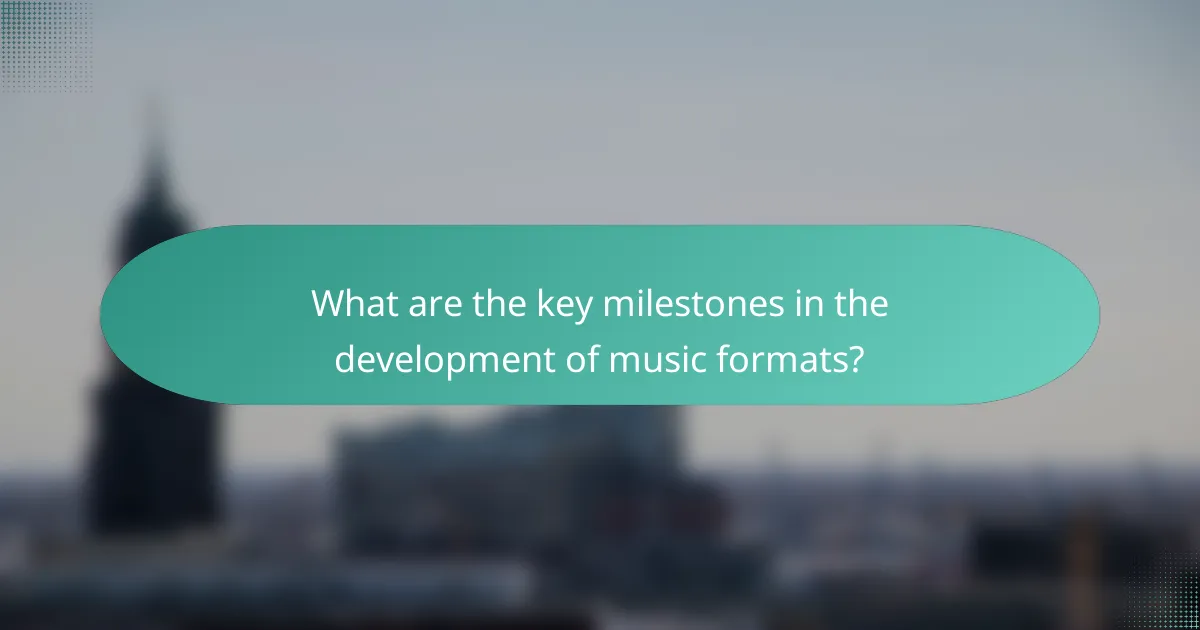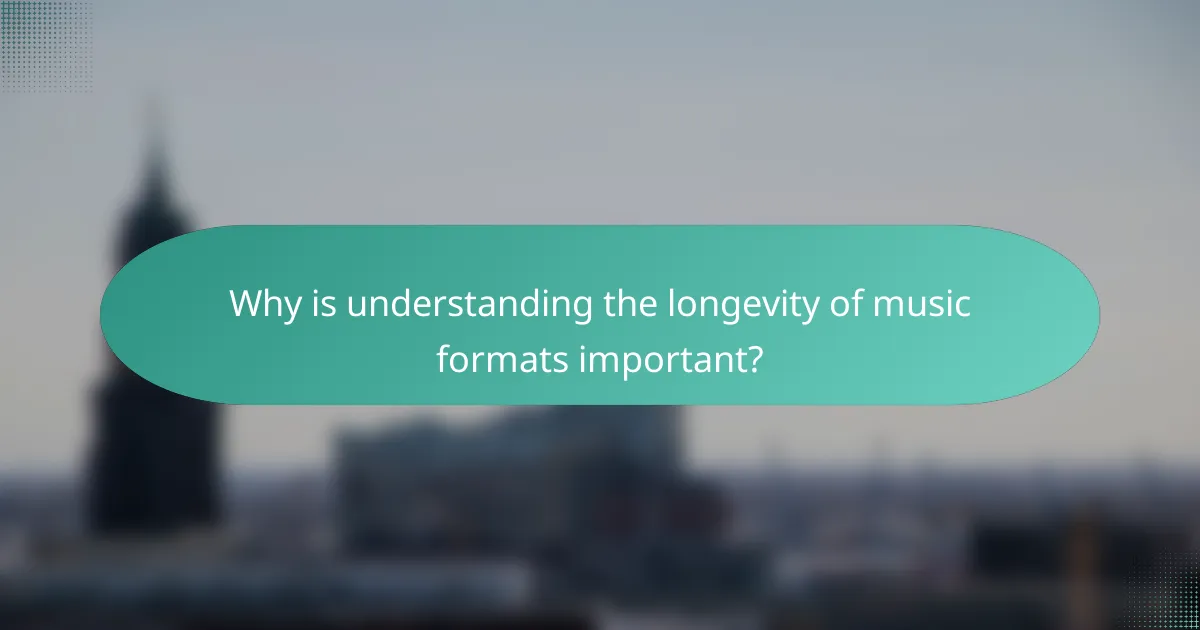The article examines the evolution of music formats, highlighting significant milestones such as the phonograph, vinyl records, cassette tapes, compact discs, MP3 files, and streaming services. Each format represents technological advancements that have influenced music accessibility and preservation. The discussion includes the longevity of different formats, emphasizing their varying lifespans and impact on cultural heritage. Additionally, the article explores future trends in music formats, focusing on high-resolution audio, immersive listening experiences, and the resurgence of vinyl records, while noting the evolving landscape of subscription models for music access.

What are the key milestones in the development of music formats?
The key milestones in the development of music formats include the invention of the phonograph in 1877. This device allowed sound to be recorded and played back for the first time. The introduction of the vinyl record in the 1940s provided a durable and high-quality medium for music. In the 1960s, the cassette tape emerged, offering portability and convenience for listeners. The compact disc was launched in the early 1980s, revolutionizing music storage with digital audio. The rise of MP3 files in the late 1990s transformed music distribution by enabling compression and online sharing. Streaming services began to dominate in the 2010s, changing how consumers access music. Each of these milestones reflects significant technological advancements that shaped the music industry.
How did cassette tapes revolutionize music consumption?
Cassette tapes revolutionized music consumption by enabling portability and personal ownership of music. They allowed users to easily record, play, and share music. This format became widely popular in the 1970s and 1980s. The compact size of cassette tapes made them convenient for car stereos and personal players. They also facilitated the rise of mixtapes, allowing individuals to curate their own playlists. The affordability of cassette players made music more accessible to the general public. By the mid-1980s, cassette sales had surpassed vinyl records, indicating a major shift in consumer behavior. This transition marked the beginning of a more personalized music experience.
What were the advantages of cassette tapes over previous formats?
Cassette tapes offered several advantages over previous formats. They provided portability, allowing users to easily carry music with them. Their compact size made them convenient for personal use in cars and portable players. Cassettes also allowed for easy recording, enabling users to create mixtapes from various sources. The format was more durable than vinyl records, which were prone to scratches and warping. Additionally, cassette tapes were less expensive to produce than earlier formats, making them widely accessible. Their popularity surged in the 1970s and 1980s, leading to a significant market presence. Overall, cassette tapes revolutionized music consumption by combining convenience, affordability, and versatility.
What impact did cassette tapes have on music accessibility?
Cassette tapes significantly enhanced music accessibility. They allowed individuals to easily record and share music. This format made music more portable and affordable. In the 1970s and 1980s, cassette tapes became widely available in stores. Their compact size enabled users to carry music in cars and walkmans. The ability to create mixtapes democratized music sharing among friends. By the mid-1980s, cassette sales surpassed vinyl records. This shift expanded the reach of various music genres to broader audiences.
What led to the transition from cassette tapes to digital formats?
The transition from cassette tapes to digital formats was driven by advancements in technology and consumer demand for better audio quality. Digital formats, like CDs and MP3s, offered superior sound clarity compared to analog cassette tapes. Additionally, digital files provided greater convenience, allowing users to store and access large music libraries easily. The rise of the internet also facilitated the distribution of digital music, making it more accessible. By the late 1990s, CD sales surpassed cassette sales, signaling a major shift in consumer preferences. The introduction of portable digital players, such as the iPod, further accelerated this transition. Overall, the combination of improved audio quality, convenience, and technological innovation led to the decline of cassette tapes in favor of digital formats.
How did technological advancements influence music formats?
Technological advancements significantly influenced music formats by enabling new methods of recording, storing, and distributing music. The introduction of magnetic tape in the 1940s revolutionized recording quality and accessibility. This led to the popularity of cassette tapes in the 1970s, allowing consumers to easily record and share music. The advent of CDs in the 1980s offered superior sound quality and durability compared to previous formats. The rise of the internet in the late 1990s facilitated digital downloads, transforming how people accessed music. Streaming services emerged in the 2000s, providing instant access to vast music libraries. Each technological leap contributed to the evolution of music formats, enhancing user experience and accessibility.
What role did consumer preferences play in this transition?
Consumer preferences significantly influenced the transition from cassette tapes to digital downloads. As technology advanced, listeners sought more convenient and portable music options. Digital formats offered easier access and storage compared to physical tapes. The rise of the internet also shifted consumer behavior towards instant gratification in music consumption. Surveys indicated that over 70% of users preferred streaming services for their vast libraries and accessibility. This shift in preference led to a decline in cassette sales, which dropped by over 90% in the early 2000s. Consequently, music industry stakeholders adapted their strategies to meet the evolving demands of consumers.
What are the defining characteristics of digital downloads?
Digital downloads are files that can be purchased and downloaded from the internet. They typically include music, videos, eBooks, and software. Digital downloads offer instant access upon purchase. They eliminate the need for physical storage media. Users can store digital downloads on various devices. They often come with licensing agreements for usage. Digital downloads can be easily shared across multiple platforms. According to the Recording Industry Association of America, digital downloads accounted for 75% of all music sales in 2020, underscoring their popularity.
How do digital downloads compare to physical formats in terms of quality?
Digital downloads generally offer comparable quality to physical formats, but with some distinctions. Digital audio can maintain high fidelity, often matching or exceeding CD quality, depending on the file format and bitrate. Lossless formats like FLAC preserve original sound quality, while lossy formats like MP3 may compress audio, potentially reducing quality. Physical formats, such as vinyl and CDs, provide tangible media that can have unique sound characteristics. For example, vinyl may introduce warmth through analog sound reproduction. However, digital downloads are more convenient and accessible. According to a study by the Audio Engineering Society, high-resolution digital formats can surpass traditional physical formats in clarity and detail, confirming the potential for superior quality in digital downloads.
What are the benefits of digital downloads for consumers?
Digital downloads offer consumers immediate access to music. They eliminate the need for physical storage and shipping. This convenience allows for instant gratification when purchasing. Additionally, digital downloads often come at a lower price compared to physical formats. Consumers can also enjoy the ability to easily organize and manage their music libraries. The portability of digital files enables listening on multiple devices. Moreover, digital downloads frequently include bonus content or high-quality audio options. These benefits contribute to a more flexible and enjoyable music consumption experience.

Why is understanding the longevity of music formats important?
Understanding the longevity of music formats is important for preserving cultural heritage. Different formats have varying lifespans and impact on accessibility. For instance, vinyl records can last decades if stored properly, while cassette tapes degrade more quickly. Digital formats, like MP3s, offer convenience but rely on technology for access. Historical context shows that formats like CDs became obsolete within a couple of decades. This knowledge helps in archiving music effectively. It also informs consumers about the durability of their collections. Understanding longevity aids in making informed decisions about music storage and preservation.
How have music formats evolved over time?
Music formats have evolved significantly over time. Initially, music was recorded on vinyl records in the late 19th century. This was followed by the introduction of cassette tapes in the 1960s, which allowed for portable music consumption. The 1980s saw the rise of compact discs (CDs), offering improved sound quality and durability. With the advent of the internet in the late 1990s, digital downloads became popular, allowing for immediate access to music. Streaming services emerged in the 2000s, further transforming how music is consumed. Each format shift has been driven by technological advancements and changing consumer preferences. According to the Recording Industry Association of America, digital music sales surpassed physical sales in 2015, highlighting this evolution.
What factors contribute to the longevity of a music format?
The longevity of a music format is influenced by several key factors. These include technological adaptability, consumer preference, and physical durability. Formats that can easily integrate with new technologies tend to last longer. For instance, CDs transitioned to digital downloads due to their compatibility with computers and mobile devices. Consumer preference plays a significant role as well. Formats that resonate with listeners often see extended use. A prime example is vinyl records, which have experienced a resurgence due to nostalgia and sound quality. Physical durability also impacts longevity. Formats that withstand wear and tear, like vinyl, often remain viable for longer periods. Historical data shows that formats like cassette tapes declined due to their susceptibility to damage. Overall, these factors collectively determine how long a music format remains relevant in the market.
Which formats have shown surprising durability in the market?
Vinyl records and digital downloads have shown surprising durability in the market. Vinyl records experienced a resurgence in popularity, with sales reaching over 27 million units in the U.S. in 2020, the highest since 1986. Digital downloads, while declining, still account for a significant portion of music sales, with over 40 billion downloads since their introduction. These formats have remained relevant due to their unique attributes. Vinyl offers a tactile experience and nostalgia, while digital downloads provide convenience. Both formats illustrate the evolving preferences of consumers in the music industry.
What challenges do music formats face in the digital age?
Music formats face several challenges in the digital age. One major challenge is the prevalence of piracy. Illegal downloading and streaming significantly reduce revenue for artists and labels. Another challenge is the rapid evolution of technology. New formats and platforms emerge frequently, causing older formats to become obsolete quickly. Quality of sound is also a concern. Compression techniques used in digital formats can degrade audio quality compared to physical formats. Additionally, market saturation complicates discovery. With countless tracks available, listeners may struggle to find new music. Finally, licensing and copyright issues pose ongoing legal challenges. These factors collectively impact the sustainability of music formats today.
How has streaming affected the relevance of traditional music formats?
Streaming has significantly diminished the relevance of traditional music formats. The rise of platforms like Spotify and Apple Music has shifted consumer preferences towards on-demand access. In 2020, streaming accounted for 83% of total music industry revenue in the U.S., overshadowing physical sales and digital downloads. Traditional formats, such as CDs and vinyl, have seen declining sales; CD sales dropped by 47% from 2019 to 2020. Vinyl records have experienced a resurgence but remain a niche market compared to streaming. Overall, streaming has transformed music consumption into an instant and convenient experience, making traditional formats less prominent.
What are the implications of format obsolescence for collectors?
Format obsolescence significantly impacts collectors by reducing the accessibility of their collections. As formats become outdated, the devices needed to play them may become scarce. This scarcity can lead to a decline in the value of the collection. Additionally, collectors may face challenges in transferring their media to contemporary formats. For example, cassette tapes and vinyl records require specialized equipment. The diminishing availability of such equipment can hinder the enjoyment of the collection. Furthermore, digital formats may offer no physical ownership, altering the collector’s experience. Collectors often seek tangible items, and the shift to digital diminishes that aspect. Ultimately, format obsolescence can lead to both financial and emotional consequences for collectors.

What future trends can we expect in music formats?
Future trends in music formats will likely focus on high-resolution audio and immersive experiences. As streaming services expand, lossless audio formats are becoming more popular. Consumers are increasingly seeking higher sound quality. Spatial audio formats, like Dolby Atmos, are gaining traction. These formats provide a more immersive listening experience. Additionally, vinyl records continue to see a resurgence in sales. This indicates a desire for physical music formats. Subscription models for music access are also evolving. Users may see more personalized music experiences in the future. Overall, the trend leans towards enhancing audio quality and user engagement.
How might emerging technologies shape the next generation of music formats?
Emerging technologies will significantly shape the next generation of music formats. Innovations such as blockchain, artificial intelligence, and spatial audio are leading this transformation. Blockchain technology can provide secure and transparent distribution of music, ensuring artists receive fair compensation. Artificial intelligence can create personalized music experiences by analyzing listener preferences and generating tailored playlists. Spatial audio technology enhances the listening experience by providing immersive soundscapes, making music feel more engaging. Additionally, advancements in data compression will allow higher quality audio files to be streamed efficiently. These technologies are not only redefining how music is created and consumed but also how it is monetized and shared. The integration of these technologies suggests a future where music formats are more interactive, personalized, and accessible.
What role will artificial intelligence play in music distribution?
Artificial intelligence will significantly enhance music distribution by optimizing processes and personalizing experiences. AI algorithms analyze listener behavior to recommend music tailored to individual preferences. This leads to increased engagement and higher streaming rates. AI can also automate distribution tasks, reducing the time and cost involved in getting music to platforms. For instance, AI tools can manage metadata and optimize release strategies based on market trends. Additionally, AI can predict hits by analyzing vast amounts of data from previous releases. This predictive capability allows artists and labels to make informed decisions about marketing and promotion. Overall, AI is transforming music distribution into a more efficient and user-centric process.
How could new formats enhance user experience in music consumption?
New formats can enhance user experience in music consumption by providing improved accessibility and interactivity. Enhanced audio quality in formats like lossless audio allows listeners to enjoy richer soundscapes. Formats such as streaming services enable on-demand access to vast libraries of music. This convenience encourages exploration of diverse genres and artists. Interactive features, like personalized playlists and recommendations, tailor the listening experience to individual preferences. Additionally, formats supporting high-resolution audio cater to audiophiles seeking superior fidelity. Research shows that 70% of users prefer streaming for its ease of use and variety. Thus, new formats significantly improve user engagement and satisfaction in music consumption.
What practical tips can help consumers adapt to changing music formats?
Consumers can adapt to changing music formats by staying informed about new technologies and services. They should explore streaming platforms, as they offer vast music libraries and convenience. Learning about file formats is essential; understanding MP3, FLAC, and others helps in choosing quality options. Utilizing music management software can simplify organization and access to music collections. Regularly backing up digital music ensures preservation against data loss. Joining online communities can provide support and updates on trends. Finally, experimenting with different playback devices can enhance the listening experience. These approaches help consumers navigate the evolving music landscape effectively.
How can listeners preserve their music collections across formats?
Listeners can preserve their music collections across formats by digitizing physical media. This process involves converting cassette tapes, vinyl records, and CDs into digital files. Software and hardware tools are available to facilitate this conversion. For example, USB turntables can convert vinyl to digital formats easily. Additionally, lossless formats like FLAC ensure high-quality audio preservation. Backing up digital files on multiple storage devices protects against data loss. Cloud storage services also offer secure options for long-term preservation. Regularly updating formats helps maintain compatibility with evolving technology. These methods ensure that music collections remain accessible and intact over time.
What should consumers consider when choosing between formats today?
Consumers should consider sound quality, convenience, and storage capacity when choosing music formats today. Sound quality varies significantly across formats. For instance, vinyl records offer rich audio but require specialized equipment. Digital formats, like FLAC, provide high fidelity with ease of access. Convenience is crucial as well; streaming services allow instant access to vast libraries. However, physical formats require space and maintenance. Storage capacity also plays a role; digital files can be stored on small devices, while physical formats take up more room. Additionally, consumers should consider format longevity; digital formats are susceptible to data loss but can be easily backed up. In contrast, physical formats can degrade over time but do not rely on technology for access.
The primary entity of this article is the evolution of music formats, specifically tracing the journey from cassette tapes to digital downloads and examining their longevity. Key milestones include the invention of the phonograph, the rise of vinyl records, cassette tapes, compact discs, and the transition to digital formats such as MP3s and streaming services. The article discusses how technological advancements and consumer preferences have influenced these changes, highlighting the advantages and accessibility of each format. It also addresses the challenges faced by traditional formats in the digital age and the implications for collectors, while exploring future trends in music consumption.